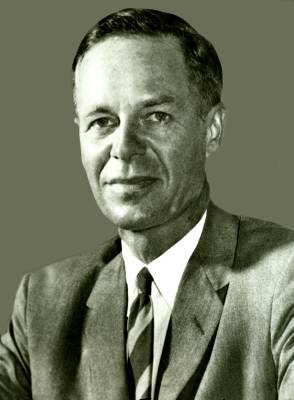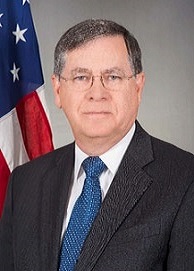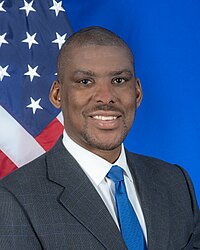The United States order of precedence is an advisory document maintained by the Ceremonials Division of the Office of the Chief of Protocol of the United States which lists the ceremonial order, or relative preeminence, for domestic and foreign government officials at diplomatic, ceremonial, and social events within the United States and abroad. The list is used to mitigate miscommunication and embarrassment in diplomacy, and offer a distinct and concrete spectrum of preeminence for ceremonies. Often the document is used to advise diplomatic and ceremonial event planners on seating charts and order of introduction. Former presidents, vice presidents, first ladies, second ladies, and secretaries of state and retired Supreme Court justices are also included in the list.
A cabinet secretary is usually a senior official who provides services and advice to a cabinet of ministers as part of the Cabinet Office. In many countries, the position can have considerably wider functions and powers, including general responsibility for the entire civil service.

Charles Woodruff Yost was a career U.S. Ambassador who was assigned as his country's representative to the United Nations from 1969 to 1971.

The Bureau of Intelligence and Research (INR) is an intelligence agency in the United States Department of State. Its central mission is to provide all-source intelligence and analysis in support of U.S. diplomacy and foreign policy. INR is the oldest civilian element of the U.S. Intelligence Community and among the smallest, with roughly 300 personnel. Though lacking the resources and technology of other U.S. intelligence agencies, it is "one of the most highly regarded" for the quality of its work.
A permanent secretary is the most senior civil servant of a department or ministry charged with running the department or ministry's day-to-day activities. Permanent secretaries are the non-political civil service chief executives of government departments or ministries, who generally hold their position for a number of years at a ministry as distinct from the changing political secretaries of state to whom they report and provide advice.
A private secretary (PS) is a civil servant in a governmental department or ministry, responsible to a secretary of state or minister; or a public servant in a royal household, responsible to a member of the royal family.

The director of policy planning is the United States Department of State official in charge of the department's internal think tank, the policy planning staff. In the department, the director of policy Planning has a rank equivalent to assistant secretary. The position has traditionally been held by many members of the U.S. foreign policy establishment. Former directors of policy planning include two national security advisors, a president of the World Bank, and several presidents of the prestigious Council on Foreign Relations.

The Office of the Secretary of Defense (OSD) is a headquarters-level staff of the United States Department of Defense. It is the principal civilian staff element of the U.S. Secretary of Defense, and it assists the Secretary in carrying out authority, direction and control of the Department of Defense in the exercise of policy development, planning, resource management, fiscal, and program evaluation responsibilities. OSD is the Secretary of Defense's support staff for managing the Department of Defense, and it corresponds to what the Executive Office of the President of the U.S. is to the U.S. president for managing the whole of the Executive branch of the federal government.

David Michael Satterfield is an American diplomat and ambassador, who has served extensively in the Middle East, including the Persian Gulf area, Lebanon, and Iraq. He later served as a senior advisor on Iraq for Secretary of State Condoleezza Rice and was director general of the Multinational Force and Observers, the peacekeeping force for the Sinai Peninsula from June 2009 until August 2017. He was chargé d'affaires to Egypt from August 2013 to January 2014 and was subsequently Special Advisor to the Secretary of State for Libya. From September 2017 to June 2019 he served as the acting assistant secretary of state for Near Eastern affairs, and was confirmed as U.S. ambassador to Turkey on June 27, 2019.
Assistant Secretary of State (A/S) is a title used for many executive positions in the United States Department of State, ranking below the under secretaries. A set of six assistant secretaries reporting to the under secretary for political affairs manage diplomatic missions within their designated geographic regions, plus one assistant secretary dealing with international organizations and one equivalent as the coordinator/ambassador at large for counterterrorism. Assistant secretaries usually manage individual bureaus of the Department of State. When the manager of a bureau or another agency holds a title other than assistant secretary, such as "director," it can be said to be of "assistant secretary equivalent rank." Assistant secretaries typically have a set of deputies, referred to as deputy assistant secretaries (DAS).

An under-secretary-general of the United Nations (USG) is a senior official within the United Nations System, normally appointed by the General Assembly on the recommendation of the secretary-general for a renewable term of four years. Under-secretary-general is the third highest rank in the United Nations, after the secretary-general and the deputy secretary-general. The rank is held by the heads of different UN entities, certain high officials of the United Nations Secretariat, and high-level envoys. The United Nations regards the rank as equal to that of a cabinet minister of a member state, and under-secretaries-general have diplomatic immunity under the UN Charter.
Assistant secretary is a title borne by politicians or government officials in certain countries and territories, usually a junior ministers assigned to a specific cabinet minister.
Undersecretary is a title for a person who works for and has a lower rank than a secretary. It is used in the executive branch of government, with different meanings in different political systems, and is also used in other organizational settings.

The Assistant Secretary of State for Political-Military Affairs is a position within the U.S. Department of State that manages the Bureau of Political-Military Affairs, charged with linking the Department of Defense and the Department of State by providing policy in the areas of international security, security assistance, military operations, defense strategy and policy, military use of space, and defense trade. The Assistant Secretary of State for Political-Military Affairs reports to the Under Secretary of State for Arms Control and International Security Affairs.
The Australian Defence Organisation (ADO) is composed of the armed forces of the Commonwealth of Australia, the Australian Defence Force (ADF), and the Australian Public Service government department, the Department of Defence which is composed of a range of civilian support organisations.
The title secretary of state or state's secretary is commonly used for senior or mid-level posts in governments around the world. The role varies between countries, and in some cases there are multiple secretaries of state in the country's system of governing the country.

The Director General of the Foreign Service is the designated manager of the United States Foreign Service.
James S. Sutterlin was an American author, academic, and officer at the United States Department of State with rank equivalent to an Assistant Secretary of State, who also spent 13 years working in various capacities for the Secretariat of the United Nations. He was Director of Research and Adjunct Professor at the Long Island University Institute for the Study of International Organizations, and a Distinguished Fellow at International Security Studies, Yale University.
Joint Secretary to the Government of India is a post under the Central Staffing Scheme and the third highest non-political executive rank in the Government of India. The authority for creation of this post solely rests with the Cabinet of India.

Provincial Civil Service, often abbreviated to as PCS, is the administrative civil service under Group A state service of the executive branch of the Government of Uttar Pradesh. It is also the feeder service for Indian Administrative Service in the state.









